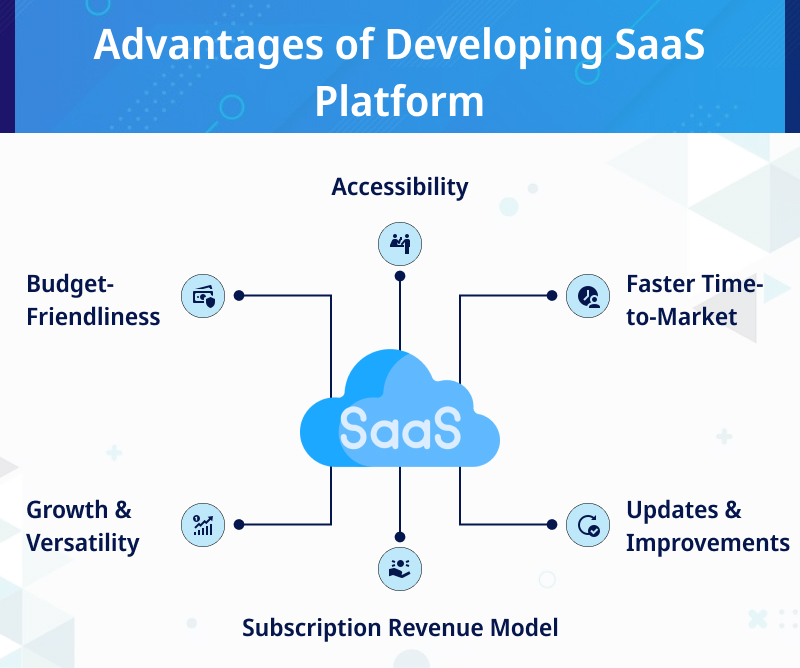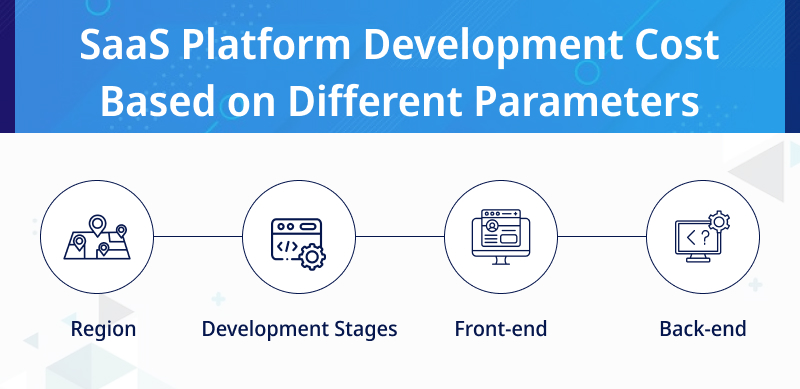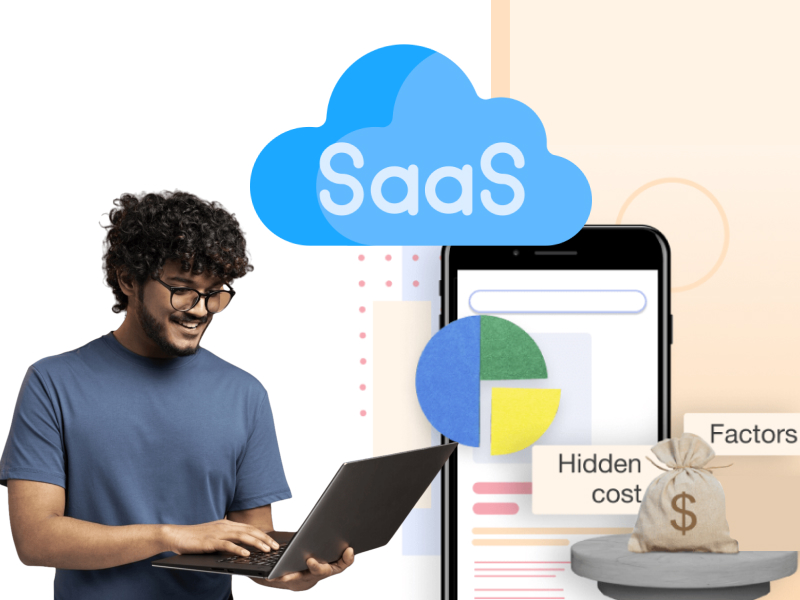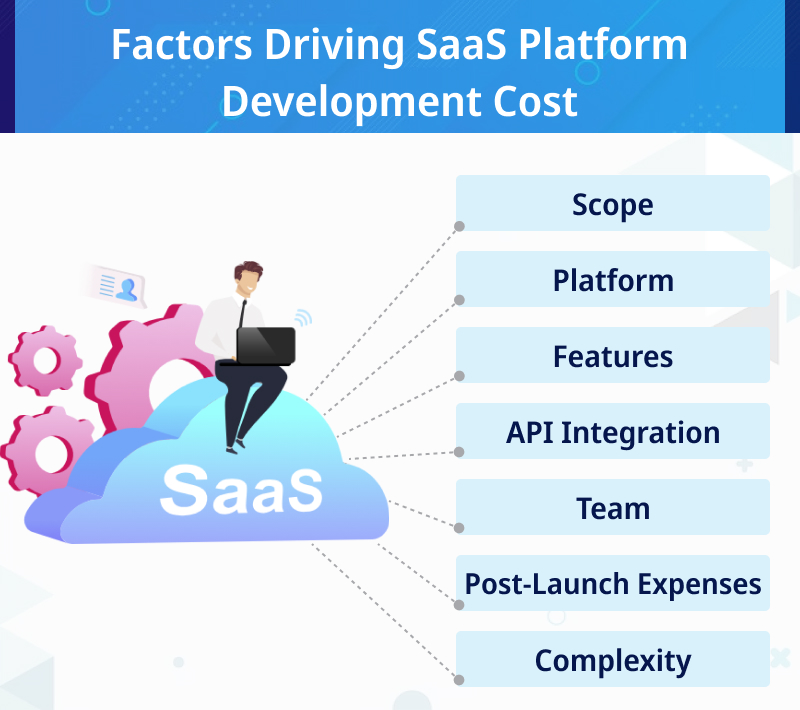Are you thinking about creating a SaaS product? Maybe you’re already in the process of making one. No matter where you are in this journey, deciding on SaaS product development is a big step, and knowing what it will cost you is important.
Remember, the price of SaaS applications isn’t just a single number. It depends on many things, like the technology used, project complexity, features, etc. David Cancel, the CEO of Drift, compared building a SaaS product to crafting a rocket ship.
So before hopping on to the final cost, you need to understand the factors, how they come together, and how much fuel you’ll need to reach your goal.
This post will cover the overall cost to create a SaaS platform. By the end of this read, you’ll have a more precise grasp of what goes into a successful SaaS product and how to determine your project’s development expenses.
Table of Contents
SaaS – A Global Market Overview
With an annual growth rate of over 11.7%, the global SaaS market is unstoppable, projected to reach a staggering $374.48 billion by 2026. Businesses worldwide embrace the SaaS revolution, drawn by its agility and scalability.
North America stands at the forefront of SaaS adoption, accounting for nearly 67% of the market share. However, the Asia-Pacific region is catching up swiftly, fueled by digital transformation initiatives.
The SaaS model’s appeal lies in its cost-efficiency – organizations can cut IT costs by 25% through its adoption.
Let's connect virtually or ask for an estimate of your project.
Business Benefits of Developing SaaS Product
Creating a SaaS product offers a range of compelling benefits that can drive business success in the modern digital landscape. As companies increasingly move towards cloud-based solutions, understanding these advantages becomes pivotal.

Let’s have a look at six significant business benefits of developing a SaaS platform:
-
Scalability & Flexibility
Did you know? According to Fortune Business Insights, the SaaS market is projected to grow at a CAGR of 18.7% from 2023 to 2030.
SaaS products are built to scale effortlessly, accommodating user growth without disruption. The scalability ensures that businesses can meet customer demands and adapt to changing market dynamics.
-
Cost-Effectiveness
SaaS eliminates the need for high upfront investments in hardware and infrastructure. A subscription-based model allows businesses to allocate resources more efficiently, minimizing initial costs and ongoing maintenance expenses.
-
Global Accessibility
SaaS products are accessible via the internet from anywhere, allowing businesses to reach a global audience without geographical constraints. It fosters expansion into new markets and enhances customer engagement.
-
Faster Time-to-Market
Did you know? Research by McKinsey found that companies adopting agile practices can reduce development time by 25-30%.
Developing a SaaS platform often involves leveraging existing frameworks and components, expediting development. This rapid development cycle means businesses can launch their products faster, gaining a competitive edge.
-
Continuous Updates & Enhancements
SaaS allows seamless updates and enhancements, ensuring users can always access the latest improvements and features. It keeps the product relevant and enhances customer satisfaction.
-
Subscription Revenue Model
The subscription-based revenue model offers a steady income stream, enhancing predictability and financial stability for businesses. It also aligns the business’s success with its customers’ success.
Also Read: 8 Ways SaaS Product Development Services Can Help Your Business to Grow
Factors Impacting the Cost of SaaS Platform Development
Creating a SaaS platform involves complex variables influencing its overall cost. Understanding these factors is essential for planning a successful and cost-effective development journey.
Here are some key elements that impact the cost of SaaS platform development:
-
Project Scope: Defining Your Path
Begin by understanding your project’s scope – whether it’s a versatile platform or a focused tool. This choice shapes the product’s features and development time. A clear scope estimation guides you in setting development timelines, particularly for platforms.
When building tools, the scope is constrained but can tackle vital functions. Take Buffer, a prime example of a SaaS tool. Platforms, on the other hand, encompass diverse functions to address various needs. The scope heavily influences development effort, time, and costs.
-
Platform Selection: Tailoring to User Preferences
Choosing the platform for your SaaS product also affects cost considerations. A web application might be ideal if your target users primarily use computers. Conversely, a mobile app suits smartphone-savvy users.
Though the core solution remains consistent between web and mobile apps, UI/UX designs and other requirements vary, influencing SaaS application costs.
-
Feature Complexity: Impact on Budget
The complexity of core features profoundly impacts your SaaS budget. Each application element carries its intricacy, which affects project time and expenses. Additional features might be necessary to enhance user satisfaction as customer feedback rolls in.
Both the quantity and type of features influence cost estimates. Common SaaS application features encompass security, communication tools, analytics, and billing. Unique projects can demand more features, leading to cost variations.
-
API Integration: Enabling Seamless Functionality
API integration is vital for SaaS apps, allowing seamless data exchange with other software. Identifying necessary APIs helps outline functionalities and tools, providing insights into associated costs.
Once your app’s needs are defined, collaborating with API providers helps develop integrations through custom code or pre-built tools. Clarity on resources and requirements assists in determining SaaS app development costs.
-
Team: Building Blocks of Success
Consider three options for assembling your SaaS app development team:
- An in-house team offers familiarity with your needs and quality outcomes.
- A SaaS development company acts as a partner in your journey.
- Freelancers provide cost savings but might compromise quality.
The chosen team significantly impacts development costs. In-house teams ensure understanding and quality, while freelancers offer affordability with potential trade-offs.
Partnering with a development company hinges on selecting a secure and budget-friendly team.
-
Post-Launch Expenses: Continual Investment for Success
Don’t assume that expenses cease after your SaaS app’s launch. Regular updates, security enhancements, and trend-aligned tools are necessary for ongoing success.
Moreover, overhead costs like licensing, subscriptions, support, and updates require separate budgeting for sustained SaaS application achievement.
-
Complexity: The Weave of Challenges
Considering the complexity of your SaaS application is essential. A more intricate solution involving multifaceted functionalities and interactions can intensify development time and costs. Balancing complexity with user needs and business goals ensures efficient resource allocation.
We’ve compiled extra details regarding the complexities of SaaS application and the associated development expenses:
|
Product Complexity |
Approximate Cost |
|
Micro SaaS |
$10000 – $25000 |
|
Basic SaaS |
$25000 – $50000 |
|
Average SaaS |
$50000 – $150000 |
|
Complex SaaS |
$150000 – $500000 |
Cost Breakdown for SaaS Platform Development
Developing a SaaS platform involves a multifaceted cost structure that can be broken down based on region and development stages. The following section provides a comprehensive look at the cost breakdown for SaaS platform development:

- Based on Region
Different regions have varying cost structures due to differences in labor rates, overhead expenses, and market dynamics.
|
Geographical Region |
Average Hourly Cost |
|
Africa |
$20-45 |
|
Asia |
$20-40 |
|
North America |
$100-200 |
|
Western Europe |
$75-150 |
|
Central/North Europe |
$50-70 |
Let's strategize together for a cost-effective and impactful launch. Contact us now to get started!
- Based on Development Stages
The SaaS development process is divided into stages, each with its associated costs. Understanding these stages can help you allocate resources efficiently:
|
Stages |
Average Cost |
|
Discovery Phase |
$1600 – $4800 |
|
UX/UI Design |
$5000 – $50000 |
|
Product Development |
$34000+ |
|
Quality Assurance |
$5000 – $20000 |
|
Launch & Maintenance |
$10000 – $20000 |
|
SaaS Hosting |
$1000 – $10000 |
Let’s have a look at the front-end development cost for SaaS platform:
|
Features |
Time (approx.) |
Rates per hour |
Average Cost |
|
Documentation & Files |
1-3 Weeks |
$1320 – $6360 |
|
|
Search |
1-2 Weeks |
$1320 – $4240 |
|
|
Preview & Download |
2-4 Weeks |
$2640 – $8480 |
|
|
Share, Access & Export |
1-2 Weeks |
$1320 – $4240 |
|
|
Total |
10-12 Weeks |
$33 – $53 |
$13200 – $25440 |
Why Choose PixelCrayons for SaaS Product Development?
When considering SaaS development, choosing the right partner to transform your vision into a reality is pivotal. While crafting a cost-effective SaaS product that stands out amidst the competition, PixelCrayons emerges as a beacon of technical prowess and innovation.
Let’s see why PixelCrayons is the optimal choice for bringing your SaaS platform to life while keeping costs in check.
-
Strategic Tech Insights for SaaS Excellence
At PixelCrayons, we don’t just build software; we architect strategic solutions. Our seasoned team possesses a profound understanding of the intricate dynamics that underpin successful SaaS platforms.
From seamless user experiences to robust scalability, we orchestrate every aspect to ensure that your SaaS product isn’t just another platform but a well-oiled machine designed for long-term prosperity.
-
Cost-effectiveness Without Compromise
The financial facet is the top concern for any SaaS venture. At PixelCrayons, we recognize this and specialize in delivering cost-effective solutions without compromising quality.
Our agile methodologies and streamlined development processes translate to reduced development cycles and lower costs, allowing you to allocate your budget efficiently across various aspects of your SaaS project.
-
Cutting-edge Technologies for Innovation
A robust SaaS platform thrives on the bedrock of cutting-edge technologies. PixelCrayons prides itself on being at the forefront of tech trends.
From cloud-native architectures to microservices, we leverage the most suitable tools to create a platform that’s agile, scalable, and ready for the future. Our tech stack contains but is not limited to:
Front-end Development: We harness the power of frameworks like React and Angular to build captivating user interfaces that ensure seamless interaction for your users.
Back-end Development: Our proficiency extends to back-end technologies like Node.js and Python, enabling us to construct the robust foundations of your SaaS platform.
Database Solutions: Leveraging databases such as MongoDB and MySQL, we create data structures that efficiently manage your platform’s information.
Cloud Mastery: Our expertise in cloud platforms like AWS and Azure ensures your SaaS product is hosted in a scalable, secure, and performance-driven environment.
-
User-centric Design Philosophy
PixelCrayons understands that an exceptional user experience is paramount.
Our design philosophy is centered around users, ensuring that your SaaS product meets their requirements and exceeds their expectations. We employ UI/UX best practices to create intuitive, elegant, and engaging interfaces.
-
Transparent Collaboration
Communication is key to every successful collaboration. With PixelCrayons, you’re not just hiring a development team but gaining a partner. We believe in transparent and frequent communication, keeping you updated on the progress of your SaaS platform every step of the way.
Final Call
Innovation comes with a price. By understanding these expenses, you can make informed choices. When moving towards the path of developing a SaaS platform, partnering with an experienced SaaS development services provider can be invaluable.
They’ll guide you through complexities, ensuring a cost-effective solution that brings your vision to life. Remember, the right partnership is key to SaaS success.
Get in touch with our expert development team for personalized cost-effective solutions. Contact us now and let's kickstart your project!
FAQs
1. What is a SaaS platform, and how does it differ from traditional software?
Ans: A Software as a Service (SaaS) platform is a cloud-based software delivery model where apps are hosted and maintained by a provider and accessed by users over the internet. Unlike traditional software, SaaS eliminates the need for users to install, update, and manage applications on their local devices. Instead, users can access the software via web browsers, streamlining deployment and reducing maintenance efforts. SaaS also offers scalability, as resources can be adjusted based on user demand. It differs from traditional software that often requires manual updates and installations, limiting flexibility and scalability.
2. How long does it take to build a SaaS platform?
Ans: The timeline for building a SaaS platform can vary significantly based on complexity, features, team size, and technology stack. Generally, a simple SaaS MVP (Minimum Viable Product) could take a few months to develop, while a more complex platform might require a year or more. Considering the planning, design, development, testing, and deployment phases is essential when accurately estimating the project’s duration.
3. What are the key features and functionalities that impact the cost of a SaaS platform?
Ans: The final cost to create a SaaS platform depends on its features and functionalities. Factors that impact costs include:
- User Roles & Permissions: The complexity of user roles and permissions affects development efforts.
- Integration: Integrating other systems, APIs, or third-party custom software development services can impact development time and cost.
- Scalability: Designing for scalability requires extra effort in architecture and infrastructure, affecting costs.
- Security: Implementing robust security measures, especially for sensitive data, can increase development costs.
- User Interface (UI) & User Experience (UX): Developing an intuitive and engaging interface can require additional design and development effort.
- Customization: Offering customizable features might increase development complexity and costs.
- Analytics & Reporting: Advanced reporting and analytics features can impact development and maintenance costs.





